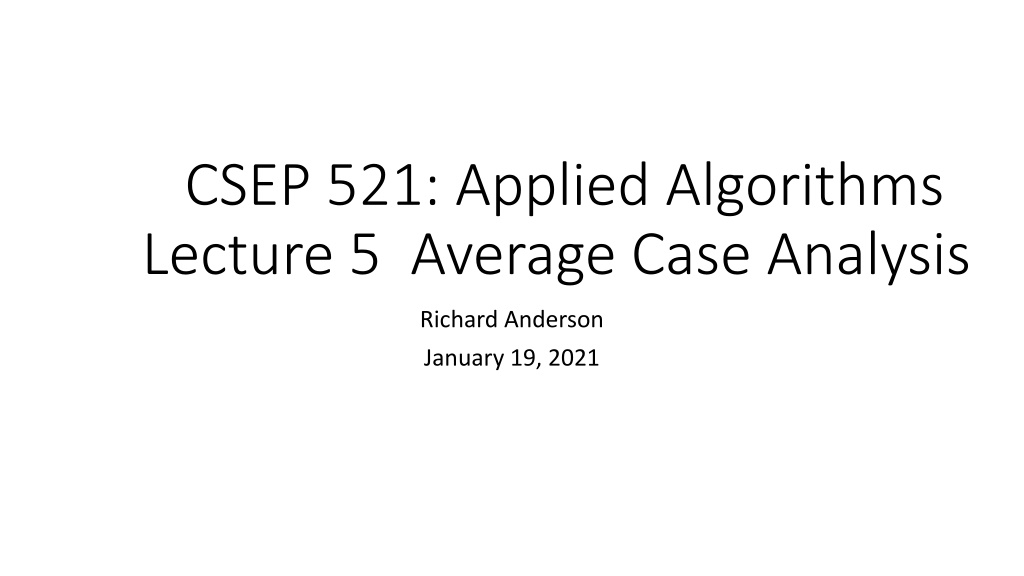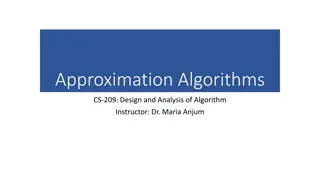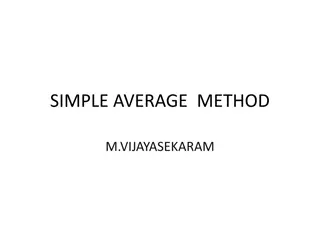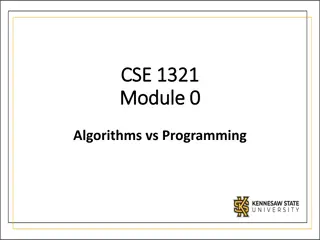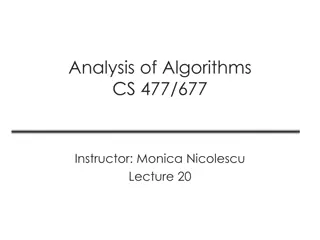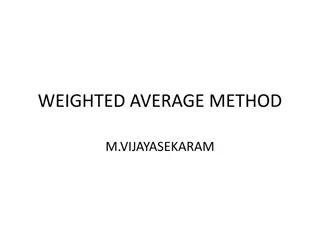Understanding Average Case Analysis of Algorithms
Explore the average case performance of algorithms, focusing on topics like stable marriage, the coupon collector problem, and formal settings for random inputs. Learn about stable matching scenarios, formal notions, and examples illustrating the concepts. Discover the formal problem of matching preferences and the idea for an algorithm addressing stability properties.
Download Presentation

Please find below an Image/Link to download the presentation.
The content on the website is provided AS IS for your information and personal use only. It may not be sold, licensed, or shared on other websites without obtaining consent from the author. Download presentation by click this link. If you encounter any issues during the download, it is possible that the publisher has removed the file from their server.
E N D
Presentation Transcript
CSEP 521: Applied Algorithms Lecture 5 Average Case Analysis Richard Anderson January 19, 2021
Announcements Office hours Oscar: 5-6 pm, Monday and Wednesday Richard: 11am-noon, Monday, 2-3 pm Friday Homework 3 is available Today, Stable Matching (Stable Marriage) Recommended reading: Kleinberg-Tardos, Chapter 1 Thursday, Random algorithm for primality testing
Average Case Performance of Algorithms Main topics for today Average case of stable marriage algorithm Coupon Collector Problem Formal setting, input is drawn randomly from a probability distribution on legal inputs Standard runtime model T(N) = max {over inputs I of size N} TA(I) Average case runtime T(N) = average {over inputs I of size N using probability distribution P} TA(I)
Stable Matching Setting: Assign TAs to Instructors Avoid having TAs and Instructors wanting changes E.g., Prof A. would rather have student X than her current TA, and student X would rather work for Prof A. than his current instructor.
Formal notions Perfect matching Ranked preference lists Stability m1 w1 m2 w2
Example (1 of 3) m1: w1 w2 m2: w2 w1 w1: m1 m2 w2: m2 m1 m1 w1 m2 w2
Example (2 of 3) m1: w1 w2 m2: w1 w2 w1: m1 m2 w2: m1 m2 m1 w1 m2 w2
Example (3 of 3) m1 w1 m1: w1 w2 m2: w2 w1 w1: m2 m1 w2: m1 m2 m2 w2
Formal Problem Input Preference lists for m1, m2, , mn Preference lists for w1, w2, , wn Output Perfect matching M satisfying stability property: If (m , w ) M and (m , w ) M then (m prefers w to w ) or (w prefers m to m ) [In other words, m and w do not want to pair up.]
Idea for an Algorithm m proposes to w If w is unmatched, w accepts If w is matched to m2 If w prefers m to m2 If w prefers m2 to m, w rejects m w accepts m, dumping m2 Unmatched m proposes to the highest w on its preference list that it has not already proposed to
Algorithm Initially all m in M and w in W are free While there is a free m w highest on m s list that m has not proposed to if w is free, then match (m, w) else suppose (m2, w) is matched if w prefers m to m2 unmatch (m2, w) match (m, w)
Example m1 w1 m1: w1 w2 w3 m2: w1 w3 w2 m3: w1 w2 w3 m2 w2 w1: m2 m3 m1 w2: m3 m1 m2 w3: m3 m1 m2 m3 w3
Cleaned up example m1 w1 m1: w1 w2 w3 m2: w1 w3 w2 m3: w1 w2 w3 m2 w2 w1: m2 m3 m1 w2: m3 m1 m2 w3: m3 m1 m2 m3 w3 Order: m1, m2, m3, m1, m3, m1
Does this work? Does it terminate? Is the result a stable matching? Begin by identifying invariants and measures of progress m s proposals get worse (have higher m-rank) Once w is matched, w stays matched w s partners get better (have lower w-rank)
Claim: If an m reaches the end of its list, then all the w s are matched
When the algorithms halts, every w is matched Why? Hence, the algorithm finds a perfect matching
The resulting matching is stable Suppose (m1, w1) M, (m2, w2) M m1 prefers w2 to w1 m1 w1 m2 w2 How could this happen?
Result Simple, O(n2) algorithm to compute a stable matching Corollary A stable matching always exists
Algorithm under specified Many different ways of picking m s to propose Surprising result All orderings of picking free m s give the same result Proving this type of result Reordering argument Prove algorithm is computing something mores specific Show property of the solution so it computes a specific stable matching
M-rank and W-rank of matching m1: w1 w2 w3 m2: w1 w3 w2 m3: w1 w2 w3 w1: m2 m3 m1 w2: m3 m1 m2 w3: m3 m1 m2 m-rank: position of matching w in preference list M-rank: sum of m-ranks w-rank: position of matching m in preference list W-rank: sum of w-ranks m1 w1 m2 w2 m3 w3 What is the M-rank? What is the W-rank?
Breakout groups Suppose there are n m s, and n w s What is the minimum possible M-rank? What is the maximum possible M-rank? Suppose each m is matched with a random w, what is the expected M-rank?
Random Preferences Suppose that the preferences are completely random m1: w8 w3 w1 w5 w9 w2 w4 w6 w7 w10 m2: w7 w10 w1 w9 w3 w4 w8 w2 w5 w6 w1: m1 m4 m9 m5 m10 m3 m2 m6 m8 m7 w2: m5 m8 m1 m3 m2 m7 m9 m10 m4 m6 If there are n m s and n w s, what is the expected value of the M-rank and the W-rank when the proposal algorithm computes a stable matching?
Stable Matching Results n m-rank w-rank Averages of 5 runs Much better for M than W Why is it better for M? 500 5.10 98.05 500 7.52 66.95 500 8.57 58.18 500 6.32 75.87 500 5.25 90.73 500 6.55 77.95 1000 6.80 146.93 1000 6.50 154.71 1000 7.14 133.53 1000 7.44 128.96 What is the growth of m- rank and w-rank as a function of n? 1000 7.36 137.85 1000 7.04 140.40 2000 7.83 257.79 2000 7.50 263.78 2000 11.42 175.17 2000 7.16 274.76 2000 7.54 261.60 2000 8.29 246.62
Coupon Collector Problem n types of coupons Each round you receive a random coupon How many rounds until you have received all types of coupons pi is the probability of getting a new coupon after i-1 have been collected ti is the time to receive the i-th type of coupon after i-1 have been received
Stable Matching and Coupon Collecting Assume random preference lists Runtime of algorithm determined by number of proposals until all w s are matched Each proposal can be viewed1 as asking a random w Number of proposals corresponds to number of steps in coupon collector problem 1There are some technicalities here that are being ignored
A more careful analysis Principle of deferred randomness Generate random list, traverse list Traverse list, generating random elements Suppose that i - 1 M s are matched, expected number of proposals until i matches What is the chance that X proposes to an unmatched W? If X has already proposed j times, the chance is (n (i j - 1))/(n-j) > (n-(i-1))/n = pi The conditioning gives a greater probability of success, reducing the expected time to success
Balls and boxes N boxes, repeatedly assign balls to random boxes Coupon collecting expected number of balls until every box is occupied How about if we assign K balls at random to N boxes How many cells are occupied? What is the expected number of balls in the first box? What is the expected maximum for the number of balls assigned to any cell?
